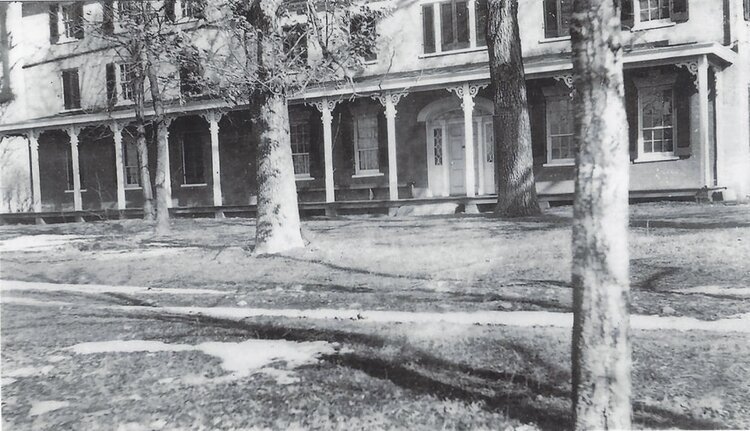George C. Marshall’s Dodona Manor
It was from Dodona Manor that Marshall was recognized for distinguished service in both world wars; earned the rank of 5-Star General; and held positions as United States Army Chief of Staff, Secretary of State, and Secretary of Defense. He also served as President of the American Red Cross; Special Envoy to China; head of a U.S. delegation to the coronation of Queen Elizabeth; architect of the Marshall Plan and the first professional soldier to be awarded the Nobel Peace Prize.
In 1805, John Drish purchased eight acres at the top of a knoll just east of Leesburg for $960 on land that had originally been owned by Landon Carter, son of Robert “King” Carter. It is likely that an early 19th-century two-story, two-room-wide brick building already stood on the property that Drish purchased.
Between 1805 and 1826, Drish grew his family and needed to grow his home as well. He constructed an elegant two-story Federal-style residence that adjoined the earlier building. The Federal-style structure is noted in the 1826 deed to Wilson J. Drish and in the 1829 deed to Fayette Ball, whose elder brother, George Washington Ball, was a nephew of George Washington. Both the 1829 sale price and the building’s footprint, identified as the ‘G. W. Ball residence’ on an 1856 map of Loudoun County, clearly indicate the presence of a substantial building.
By 1856, Ball sells the land and house to Reverend Charles Nourse for $5,250. Nourse was the principal of Leesburg Academy, a boarding school that taught young girls from wealthy white families manners and etiquette of upper-class society. By 1859, the residence had undergone two major alterations: a two-story brick service ell had been added on the east side, and on the north side the early 19th century building had been encapsulated by a hallway and third floor addition to allow for more bedrooms for the students. Unfortunately, with the impending Civil War, the school’s attendance declined and forced its closure in 1859.
An advertisement appearing in the 1859 Democratic Mirror of Leesburg announced that the residence, then known as Oak Hill, was for sale. Describing a 16-room house with good cellars, the public notice also mentioned several outbuildings including carriage, ice and meat houses, cow shed, stable, and a building for servants. Those were later demolished sometime during the early 20th century.
"Elvon" during the Pike residency, circa 1910.
After the house was sold several more times, Yvon and Ella Pike purchased the 3.52 acres in 1907 for $6,000. The couple renamed the home by combining their names to create “Elvon.” For 28 years the Pike family enjoyed Victorian-era Leesburg and their picturesque home. As was common during this time, a full-length wood and cast-iron porch was added to the front façade of the home, changing its look.
The last owners of this house before the Marshalls came to Leesburg were Northcutt and Marcia Ely. Northcutt was a prominent lawyer in the Herbert Hoover administration and considered this fine home a prime location for impressing political guests. The name “Dodona Manor” is actually thanks to the Elys. The Oracle of Dodona is located in northwestern Greece and is the oldest Hellenic oracle, dating to the 2nd millennium BCE. The legendary author Homer described Dodona as an oracle of Zeus where ancient priests would use the rustling of the white oak tree leaves to interpret messages from Zeus himself. The well-educated Elys recognized the prolific plantings of white oaks on this property and thought the reimagined name was appropriate. Throughout their residency, the Elys added the modern conveniences of electricity, central oil heating, and indoor plumbing.
George and Katherine Marshall in front of Dodona Manor, 1951
The house remained largely unchanged when the Marshalls purchased Dodona Manor from Northcutt Ely as a retreat from their public life in Washington. It’s said that Katherine was driving through Leesburg when she saw a “for sale” sign in the lawn of this property. After making a $10 down payment to secure the house, the Marshalls finally purchased Dodona Manor for $16,000 in the spring of 1941. The Marshalls made certain interior cosmetic changes to the home, including new wallpaper for the living, dining, and breakfast rooms, and fresh paint for the trim and walls in other rooms. The 3.8 acres of grounds and gardens were also trimmed and planted. Marshall often engaged in his favorite pastime, vegetable gardening, while at Dodona.
Following the death of General Marshall in 1959, his wife moved to their second home in Pinehurst, North Carolina, giving Dodona to her oldest daughter Molly and her husband James Winn. Molly lived in the home until she sold the property to the George C. Marshall Home preservation fund, later the GCMIC, which engaged in a 10-year, $7 million restoration of the home. On Veterans Day in 2005, Dodona Manor was open to the public as a museum.
Today, Dodona Manor stands as a time capsule of architectural and personal history. The collection boasts over 6,000 objects, 90 percent of which belonged to George and Katherine Marshall. From furniture to letters, artwork, and textiles, the story of the Marshalls lives on both in the objects preserved today and the history connected to those objects.
You can see all the titles of the Marshall’s book collection here.
Aerial View of Dodona Manor, 1941




